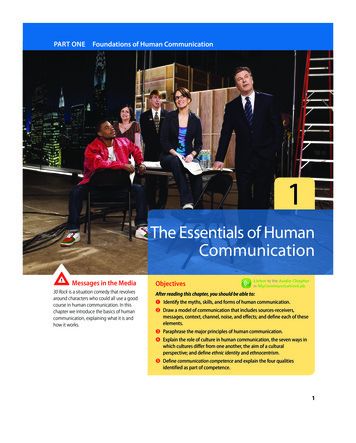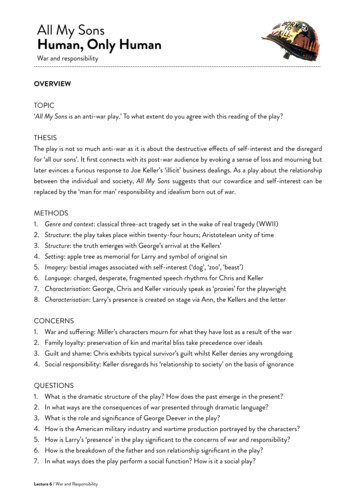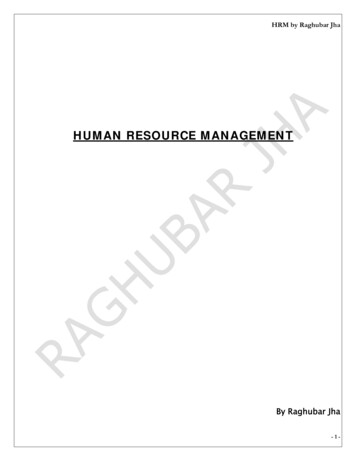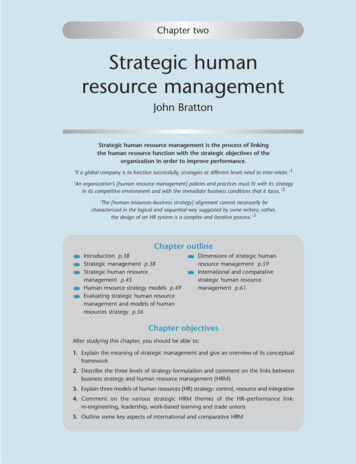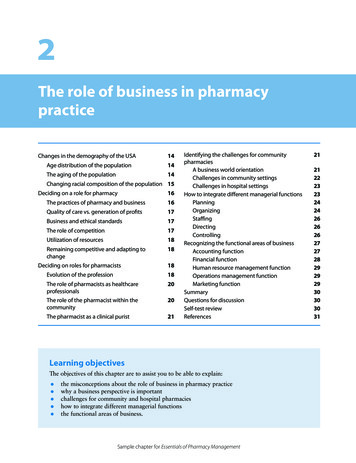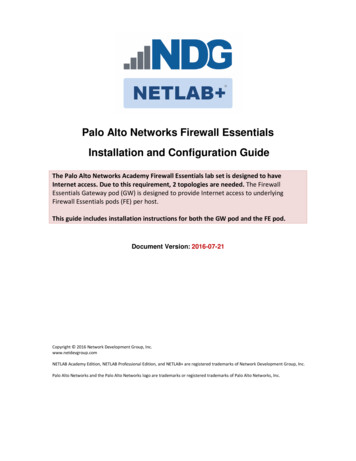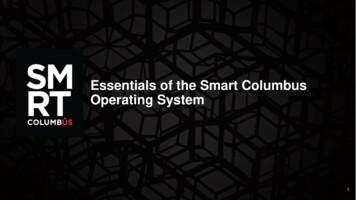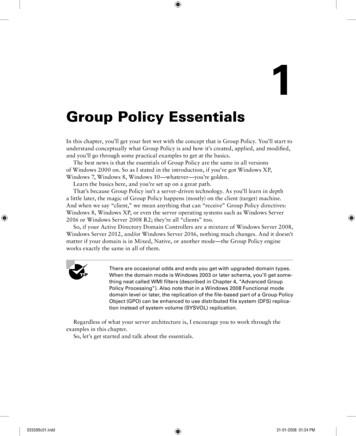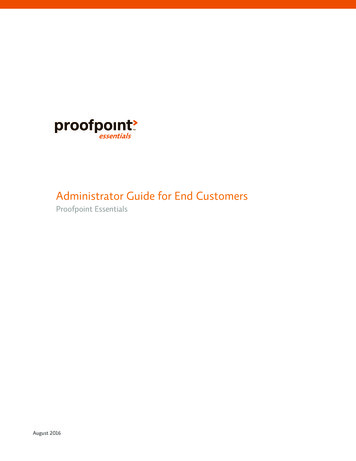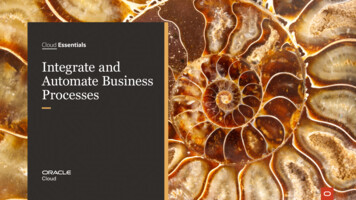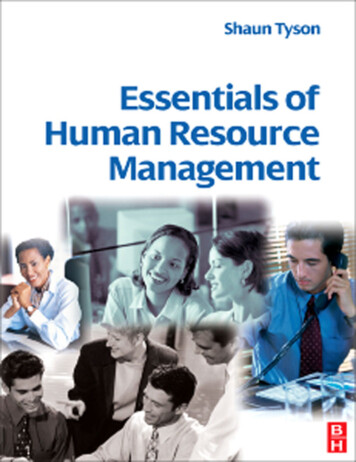
Transcription
Essentials of HumanResource Management
This page intentionally left blank
Essentials ofHuman ResourceManagementFifth editionShaun TysonAMSTERDAM BOSTON HEIDELBERG LONDON NEW YORK OXFORDPARIS SAN DIEGO SAN FRANCISCO SINGAPORE SYDNEY TOKYOButterworth-Heinemann is an imprint of Elsevier
Butterworth-Heinemann is an imprint of ElsevierLinacre House, Jordan Hill, Oxford OX2 8DP30 Corporate Drive, Suite 400, Burlington, MA 01803, USAFirst published as Personnel Management 1982Second edition 1989Third edition 1996Fourth edition 2000Fifth edition 2006Copyright 1982, 1989, 1996, 2000, Shaun Tyson and Alfred York. All rights reservedCopyright 2006, Shaun Tyson. Published by Elsevier Ltd. All rights reservedThe right of Shaun Tyson to be identified as the author of this work has beenasserted in accordance with the Copyright, Designs and Patents Act 1988No part of this publication may be reproduced, stored in a retrieval system ortransmitted in any form or by any means electronic, mechanical, photocopying,recording or otherwise without the prior written permission of the publisherPermissions may be sought directly from Elsevier’s Science & Technology RightsDepartment in Oxford, UK: phone ( 44) (0) 1865 843830; fax ( 44) (0) 1865853333; email: permissions@elsevier.com. Alternatively you can submit your requestonline by visiting the Elsevier web site at http://elsevier.com/locate/permissions, andselecting Obtaining permission to use Elsevier materialNoticeNo responsibility is assumed by the publisher for any injury and/or damage topersons or property as a matter of products liability, negligence or otherwise, or fromany use or operation of any methods, products, instructions or ideas contained in thematerial herein. Because of rapid advances in the medical sciences, in particular,independent verification of diagnoses and drug dosages should be madeBritish Library Cataloguing in Publication DataA catalogue record for this book is available from the British LibraryLibrary of Congress Cataloguing in Publication Data Control Number: 2006923608ISBN-13: 978-0-7506-6795-1ISBN-10: 0-7506-6795-8For information on all Elsevier Butterworth-Heinemann publicationsvisit our web site at http://books.elsevier.comTypeset by Charon Tec Ltd, Chennai, Indiawww.charontec.comPrinted and bound in The Netherlands06 07 08 09 10 10 9 8 7 6 5 4 3 2 1
ContentsPart OnePart TwoPrefaceAcknowledgementsviixiThe behavioural bases of humanresource management112332142Individual differencesGroupsOrganizationsThe developing strategic role ofhuman resource management456From personnel management to HRM: how did thisfield of work develop?Human resource strategyHuman resource planningPart Three Recruitment and selection789Part FourJob analysis: defining effective performanceRecruitmentSelecting employeesAssessing performance anddeveloping people101112InductionAssessing performance potentialTraining and development596184107125127143161181183192214
viPart FiveContentsRewards131415Part SixJob evaluationPay and benefitsConditions of serviceIndustrial relations16171819202122The history and development of trade unionsCollective bargainingNegotiation techniquesDisputes and ways of resolving conflictConsultation and participationEmployment law: institutions and contracts of employmentEmployment law: managing employment relationshipsPart Seven Epilogue23The contribution of HRM to organizational 447Appendix 1Appendix 2451453Index457
PrefaceHuman Resource management has grown in its range and depth to thepoint where it has become an industry rather than just an occupation.This Fifth Edition of a book aimed at explaining the main areas of thefield has grown in each edition, expanding with the scope of the topicto the point where even a summary of the topic is a large tome. In eachsucceeding edition we find new ideas, new techniques and new legislation to describe. There is however, no diminution in the volume ofexisting material because all is still relevant. It is necessary to know howwe have come to our present situation in order to understand wherewe are going, and the trends which are continuing. HRM is highly situation specific, the context is infinitely variable and there are endlessapplications.Part of the joy of working in HRM is the significance of the work thatwe do in this field, to help people and organizations to adjust to themassive social, economic, political and technological changes thatinfluence the way people are managed.The pace of change is such that we must acknowledge wider forcesaffecting people management. Environmental change, increased security risks, demographic changes, the rise of new economies such asChina, India and Brazil, and the expansion of the EU are some of theobvious global pressures. The social changes we can all list includeshifts to values and lifestyles, families, education and health. What atone time might have seemed remote from HRM is now central to ourwork. Global, social and political changes affect all economic activities,through marketing opportunities and threats, affecting employment,costs, productivity and the social climate of relationships.New ways of working and organizing, such as flatter, more devolvedorganization structures, the burgeoning range of networks, whether
viiiPrefacetechnological, inter-organizational, intra-organizational, or personal,and global ownership with international activities as a norm haveaffected HRM. The HR functions in organizations are smaller andmore often linked to a wide range of service providers and sometimeswith the transactional activities outsourced. The HR role is diffusedthroughout organizations, with new job titles reflecting the significance of change management and talent management.Not in spite of, but because of, these trends, there is every sign thatHRM as an activity is itself becoming widely distributed. There is convergence in practices for example, between the public and private sectors,and across national boundaries. Information flows are so fast the standard for communications is now instant, via electronic means, that thelatest ideas on the HR field are transmitted within seconds. There is transparency in areas such as pay and benefits, labour market data, recruitment opportunities and working trends. The world of the business ofHRM is mature, expanding and mainstream to all managerial activity.These trends and changes would be sufficient justification for theFifth Edition of this text alone. The need for this kind of text continuesbecause whatever the discontinuities arising from the new challenges,people management in all its aspects builds and develops from tradition and techniques. New cases and legislation in the field amend andmarginally reconfigure regulations, with our understanding of thehuman condition comes a slow accretion of knowledge which is represented in the continuing traditions in techniques and approaches,such as in selection, job evaluation, reward, training, development andin industrial relations. The people working in this field are developingknowledge and techniques as they face new problems, as communitiesof practitioners.The latest edition of this text seeks to bring together the main fundamental knowledge of areas of human resources, from organizationalbehaviour to people management, industrial relations and employmentlaw. These are explored from the perspective of the current and emerging context of HRM and the latest techniques in managing people.The themes of continuity and change are supported by the genesisof this book, when Alfred York, the original co-author and I sat downtogether to blend our joint knowledge and interests as a foundationfor the book, with John Milton’s words in mind:‘Where there is much desire to learn, there of necessity will be mucharguing, much writing, many opinions; for opinion in good men is butknowledge in the making.’Our desire to write the book was born as much out of a desire to learnas the intention to communicate ideas and understanding.
PrefaceixThat desire continues, because with each new edition, come revisions and new ideas. The field of HRM is one where there are new techniques and fresh concepts by the bucketful, and where no book cancompletely do justice to the topic.This book is intended for anyone who wishes to find a comprehensive guide to the subject, grounded in the principal theories and concepts, with the authority of a long term perspective and a focus on thelatest techniques and practical ideas.Later in these introductory pages I acknowledge my debt to Alfredand to Jayne Ashley who over many years and editions have worked onthis book with me. In the ideas and perspectives found here, we hopeour readers will find ‘knowledge in the making’.Shaun Tyson
This page intentionally left blank
AcknowledgementsWe wish to acknowledge with thanks the permissions to reproduce thematerial from the following works, granted by the publishers andauthors:The model of strategic change and human resource management,granted by Chris Hendry and Andrew Pettigrew, and by Routledge andJohn Wiley, originally published in the International Journal of HumanResource Management (1990) 1 (1) 17–44, and in the British Journal ofManagement (1992) 3 (3), 137–56.The model of HRM from Human Resource Management: A GeneralManagers Perspective by Michael Beer, Bert Spector, Paul R. Lawrence,D. Quinn Mills and Richard E. Walton. Reprinted with permissionfrom Professor Michael Beer.Ashkenas, R, Ulrich, D., Jich, T. and Kerr, S., copyright 1995. TheBoundaryless Organisation. Jossey Bass. Reprinted with permission ofJohn Wiley & Sons, Inc.The cohort analysis from Manpower Planning in the Civil Service (1972),Table 5.1, Crown Copyright, which is reprinted with the permission ofthe Controller of Her Majesty’s Stationery Office.The table entitled Changes resulting from the impact of technologyfrom The Future of Work by Ward (1990) in Anderson J. and Ricci, M(eds) Society and Social Science. Reprinted with the permission of theOpen University Press.The panel entitled Demographic changes and the workplace:Implications for HR. Reprinted with the permission of SHRM2004–2005 Workplace forecast: A Strategic Outlook published by theSociety of Human Resource Management, Alexandria, VA.Boston Consulting Group Matrix – Boston Consulting Group –Reprinted with the permission of the Boston Consulting Group.
xiiAcknowledgementsKraft Foods Vision Statement – Reprinted with the permission ofKraft Foods.Cadbury Schweppes Mission Statement – Reprinted with the permission of Cadbury Schweppes.The dynamics of the stress process (p. 310) – Reprinted with the permission of Resource Systems Limited.Keith Cameron for permission to quote his chart on commissionschemes and to publish his format of a flexible reward system.British Aerospace (for a description of their BEST managementdevelopment programme objectives) and Standard Life (for a description of their contribution management system).I wish to express my thanks in particular to Michelle Chamberlain,Practice Lawyer, of Eversheds LLP for her helpful comments andadvice on the employment law chapter.This book is a revised text, and much of the original remains. Whilstcompleting these revisions I have been conscious throughout that myold friend Alfred York was my original co-author. Sadly, ill health has prevented him from continuing in this role. Nevertheless, as I brought thisedition up to date, I was conscious that Alfred’s ideas and personality areimbued in the heart of the book. He is a person whose intellect and lifeexperience have reached ‘renaissance man’ proportions, having been anaval officer during the second world war, and RAF officer after the war,a classics scholar, a linguist, an academic and a management consultant.I hope this book will be a continuing testament to his genius.There is a second great debt of gratitude owed. The book would nothave been realised without the professional diligence of Jayne Ashley.Her good humour, her painstaking and tireless attention to the manuscript have made the whole project possible.I am also grateful for the patience of our publisher, Maggie Smith ofElsevier, who has been a constant source of encouragement.Any errors or omissions remain my responsibility alone.Shaun TysonCranfield Bedfordshire
P A R TO N EThe behavioural basesof human resourcemanagementIn this part of the book we provide a general background for all thesubsequent chapters on specific aspects of human resource management (HRM) policies and practices. Since work and its managementare human activities set in motion, carried out, supervised, monitoredand assessed by people who are constantly interacting with each other,human factors are crucially important. Nevertheless, managers do notalways act as though they fully understand and acknowledge that success in management has to be based on an awareness and at least abroad knowledge of human behaviour, including, of course, their own.For the last 100 years there have been studies of the behaviour ofpeople, and in particular of the special kinds of problems that modernworking life creates. These studies are described collectively as thesocial sciences and include contributions from specialists trained in avariety of disciplines, particularly in the different branches of psychology, sociology and economics. In times of increasing academic specialization we need to remind ourselves that the situations themselves haveno such specialized distinctions. The value of the various specialismslies in the difference of emphasis and perspective that they give inlooking at the same situations, and hence in providing a broaderunderstanding of their nature.
2Essentials of human resource managementIn this preliminary phase of the book we are setting out to make asystematic survey of the important areas covered by research into thebehaviour of
04.12.2012 · mental knowledge of areas of human resources, from organizational behaviour to people management, industrial relations and employment law. These are explored from the perspective of the current and emerg- ing context of HRM and the latest techniques in managing people. The themes of continuity and change are supported by the genesis of this book, when Alfred York, the original co
